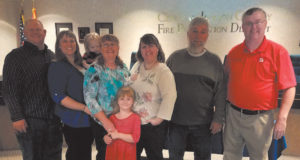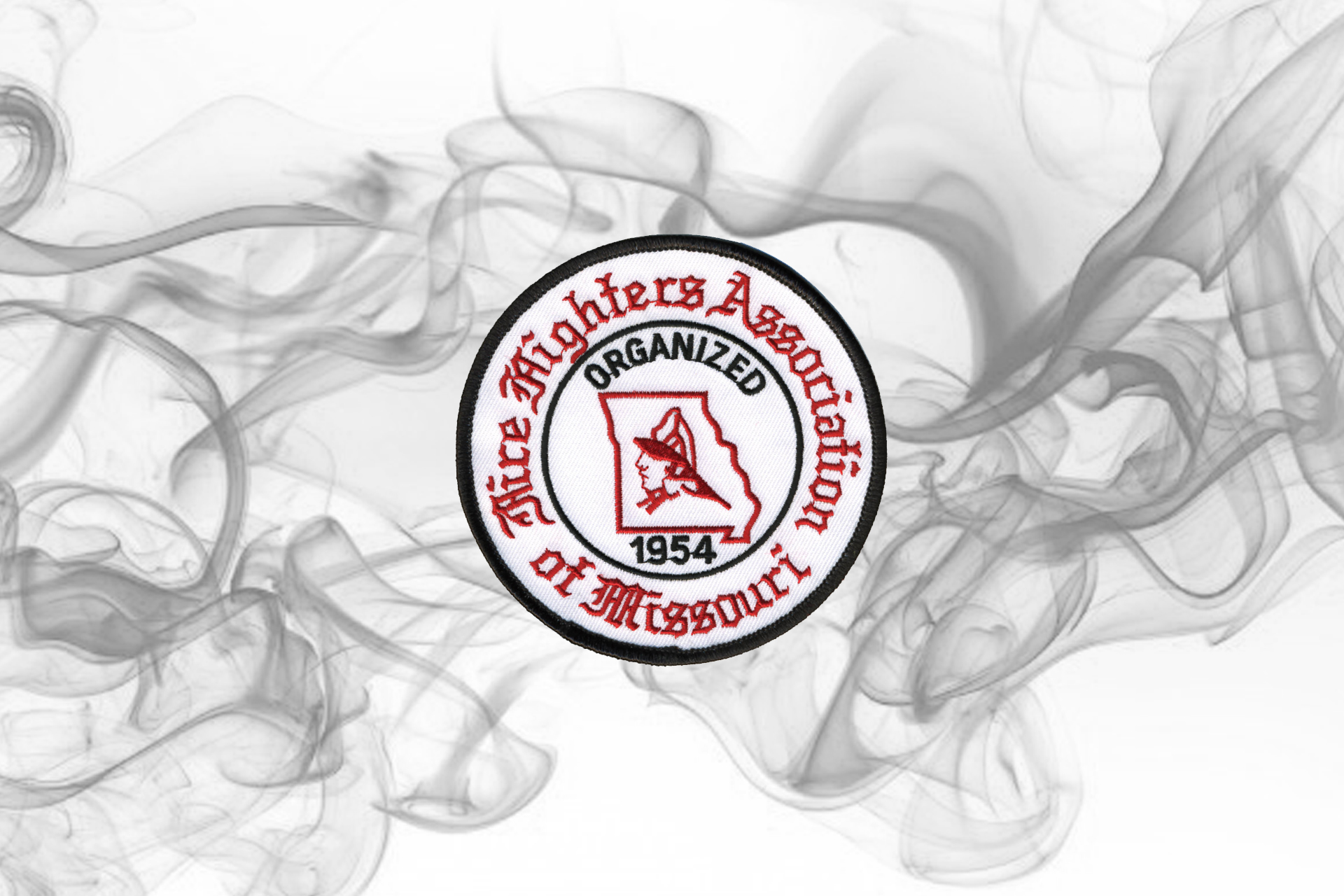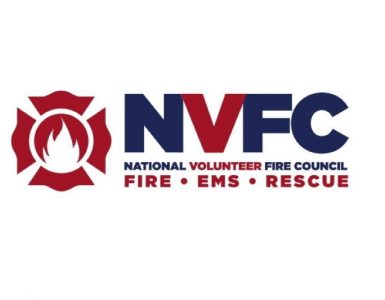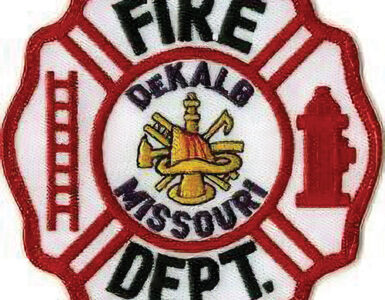 Greetings, I hope everyone had a Merry Christmas and a Happy New Year. On November 3, I traveled to the Lake of the Ozarks to attend the MU Fire and Rescue Training Institute’s, Missouri Emergency Services Instructor Conference. This conference is for instructors that do emergency services training for our fellow firefighters and EMS workers in the state. Kevin and his staff put on a great conference and great training for the instructors. The training included several train the trainers including basic firefighter skills, live burn training, and water supply for rural and urban departments to name a few. Great speakers and also naming the Instructor of the Year for the institute. Kevin and Gail did a great job with this as always. Keep up the great work, and thank you for what you do!
Greetings, I hope everyone had a Merry Christmas and a Happy New Year. On November 3, I traveled to the Lake of the Ozarks to attend the MU Fire and Rescue Training Institute’s, Missouri Emergency Services Instructor Conference. This conference is for instructors that do emergency services training for our fellow firefighters and EMS workers in the state. Kevin and his staff put on a great conference and great training for the instructors. The training included several train the trainers including basic firefighter skills, live burn training, and water supply for rural and urban departments to name a few. Great speakers and also naming the Instructor of the Year for the institute. Kevin and Gail did a great job with this as always. Keep up the great work, and thank you for what you do!
November 21, was a special day for our former FFAM Secretary and Treasurer Dale Arnold. Dale retired from the fire service after a 40 year career. Dale started his career with the Carrollton Fire Department and served for nine years before moving on to Central Jackson Fire Protection District where he served thirty-one years moving thru the ranks and retiring as a captain. Dale served nine years as a assistant director to one of our founders of the FFAM Joe Jackson, and eventually served as Secretary/Treasurer for our organization from 1989-2011. Dale also served on the memorial committee for several years. I attended Dale’s retirement ceremony in Blue Springs, lots of good things were said including words from our State Fire Marshal Tim Bean, who also presented Dale with an award, thanking him for his service. Dale enjoy retirement and spoil those grand-daughters of yours, I think you have earned it.
On Christmas Eve we had a close call in our state. An engine with the St. Clair Fire Protection District was struck by a semi. The crew was responding to a motor vehicle accident. As they were exiting the cab, the engine was struck. Fortunately no injuries to the crew. Remember to slow down and move over when you see emergency workers working on our highways. Glad to see that none of our brothers and sisters of the St. Clair Fire Protection District were injured.
On Christmas Day, I saw a news story on KSDK Channel 5 out of St. Louis, doing a story on the Eureka Fire Protection District and how the spend the holidays while on shift. The story tells how headquarters cooks for all their stations, how they invite their families in so crew members can enjoy the Christmas holiday with their kids and family. They even forgot a thermometer when they were deep frying a turkey, and used their TIC to see how hot their oil was, cleaver thinking for sure. Firefighter Alex Hawkins did a great job being the spokesman for the group. Chief Brown you should be proud of your personnel, they were professional on screen and thank you for taking care of our brothers and sisters in Eureka.
Well, winter is upon us, many of us have experienced extreme temperatures and even some snow already. Here are some tips from FEMA to keep in mind during the winter months.
Before Snowstorms and Extreme Cold
- Make a family communication plan. Your family may not be together when disaster strikes, so it is important to know how you will contact one another, how you will get back together and what you will do in case of an emergency.
- Make an emergency kit for at least three days of self-sufficiency.
- Keep space heater safety in mind: Use electric space heaters with automatic shut-off switches and non-glowing elements. Remember to keep all heat sources at least three feet away from furniture and drapes.
- Prepare your home:
- Make sure your home is well insulated and that you have weather stripping around your doors and window sills to keep the warm air inside.
- Make sure you have a working carbon monoxide detector.
- Keep fire extinguishers on hand, and make sure everyone in your house knows how to use them. House fires pose an additional risk, as more people turn to alternate heating sources without taking the necessary safety precautions.
- Learn how to shut off water valves (in case a pipe bursts).
- Insulate your home by installing storm windows or covering windows with plastic from the inside to keep cold air out.
- Hire a contractor to check the structural ability of the roof to sustain unusually heavy weight from the accumulation of snow – or water, if drains on flat roofs do not work.
- If you have a wood burning fireplace, consider storing wood to keep you warm if winter weather knocks out your heat. Also, make sure you have your chimney cleaned and inspected every year.
- Have at least one of the following heat sources in case the power goes out:
- Extra blankets, sleeping bags and warm winter coats
- Fireplace or wood-burning stove with plenty of dry firewood, or a gas log fireplace
- Prepare your vehicle:
- Fully winterize your vehicle: Have a mechanic check antifreeze, brakes, heater and defroster, tires, and windshield wipers to ensure they are in good shape. Keep your gas tank at least half full.
- Keep an extra emergency kit in your car. In addition to the basic essentials, consider adding a portable cell phone charger, ice scraper, extra blanket, sand for traction and jumper cables.
- Rock salt or more environmentally safe products to melt ice on walkways. Visit the EPA for a complete list of recommended products.
- Sand to improve traction.
- Make sure you have a cell phone with an emergency charging option (car, solar, hand crank, etc.) in case of a power failure.
- People who depend on electricity to operate medical equipment should have alternate arrangements in place in case power is out for an extended period of time.
- Plan to check on elderly/disabled relatives and neighbors.
- Plan to bring pets inside.
- Know where the manual release lever of your electric garage door opener is located and how to operate it in case you lose power.
- Fill a gallon container with water and place them in the freezer to help keep food cold.
- A NOAA Weather Radio broadcasts alerts and warnings directly from the NWS for all hazards. You may also sign up in advance to receive notifications from your local emergency services.
During Snowstorms and Extreme Cold
- Stay indoors during the storm.
- Drive only if it is absolutely necessary. If you must drive: travel in the day; don’t travel alone; keep others informed of your schedule and your route; stay on main roads and avoid back road shortcuts.
- Walk carefully on snowy, icy, walkways.
- Avoid overexertion when shoveling snow. Overexertion can bring on a heart attack—a major cause of death in the winter. Use caution, take breaks, push the snow instead of lifting it when possible, and lift lighter loads.
- Keep dry. Change wet clothing frequently to prevent a loss of body heat. Wet clothing loses all of its insulating value and transmits heat rapidly.
- If you must go outside, wear several layers of loose-fitting, lightweight, warm clothing rather than one layer of heavy clothing. The outer garments should be tightly woven and water repellent.
- Wear mittens, which are warmer than gloves.
- Wear a hat and cover your mouth with a scarf to reduce heat loss.
Cold Related Illness
- Frostbite is a serious condition that’s caused by exposure to extremely cold temperatures.
- A white or grayish-yellow skin area
- Skin that feels unusually firm or waxy
- Numbness
- If you detect symptoms of frostbite, seek medical care.
- Hypothermia, or abnormally low body temperature, is a dangerous condition that can occur when a person is exposed to extremely cold temperatures. Hypothermia is caused by prolonged exposures to very cold temperatures. When exposed to cold temperatures, your body begins to lose heat faster than it’s produced. Lengthy exposures will eventually use up your body’s stored energy, which leads to lower body temperature.
- Warnings signs of hypothermia:
- Adults: shivering, exhaustion, confusion, fumbling hands, memory loss, slurred speech drowsiness
- Infants: bright red, cold skin, very low energy
- If you notice any of these signs, take the person’s temperature. If it is below 95° F, the situation is an emergency—get medical attention immediately.
Carbon Monoxide
Caution: Each year, an average of 430 Americans die from unintentional carbon monoxide poisoning, and there are more than 20,000 visits to the emergency room with more than 4,000 hospitalizations. Carbon monoxide-related deaths are highest during colder months. These deaths are likely due to increased use of gas-powered furnaces and alternative heating, cooking, and power sources used inappropriately indoors during power outages.
- Never use a generator, grill, camp stove or other gasoline, propane, natural gas or charcoal burning devices inside a home, garage, basement, crawlspace or any partially enclosed area. Locate unit away from doors, windows and vents that could allow carbon monoxide to come indoors. Keep these devices at least 20 feet from doors, windows, and vents.
- The primary hazards to avoid when using alternate sources for electricity, heating or cooking are carbon monoxide poisoning, electric shock and fire.
- Install carbon monoxide alarms in central locations on every level of your home and outside sleeping areas to provide early warning of accumulating carbon monoxide.
- If the carbon monoxide alarm sounds, move quickly to a fresh air location outdoors or by an open window or door.
- Call for help from the fresh air location and remain there until emergency personnel arrive to assist you.
Stay or Go?
STAY:
- If stuck on the road to avoid exposure and/or when rescue is likely
- If a safe location is neither nearby or visible
- If you do not have appropriate clothing to go outside
- If you do not have the ability to call for help
GO:
- If the distance to call for help is accessible.
- If you have visibility and outside conditions are safe.
- If you have appropriate clothing.
- Once the storm has passed, if you are not already home, follow instructions from your local transportation department and emergency management agency to determine if it is safe to drive and, if so, which route will be safest for you to get home. Drive with extra caution.
After Snowstorms and Extreme Cold
- If your home loses power or heat for more than a few hours or if you do not have adequate supplies to stay warm in your home overnight, you may want to go to a designated public shelter if you can get there safely. Text SHELTER + your ZIP code to 43362 (4FEMA) to find the nearest shelter in your area (e.g., SHELTER20472)
- Bring any personal items that you would need to spend the night (such as toiletries, medicines). Take precautions when traveling to the shelter. Dress warmly in layers, wear boots, mittens, and a hat.
- Continue to protect yourself from frostbite and hypothermia by wearing warm, loose-fitting, lightweight clothing in several layers. Stay indoors, if possible.
Winter Weather Watches and Warnings
- Familiarize yourself with these terms to help identify an extreme winter weather alerts:
- Freezing Rain – Rain that freezes when it hits the ground, creating a coating of ice on roads, walkways, trees and power lines.
- Sleet – Rain that turns to ice pellets before reaching the ground. Sleet also causes moisture on roads to freeze and become slippery.
- Wind Chill- Windchill is the temperature it “feels like” when you are outside. The NWS provides a Windchill Chart to show the difference between air temperature and the perceived temperature and the amount of time until frostbite occurs. .
- Winter Weather Advisory – Winter weather conditions are expected to cause significant inconveniences and may be hazardous. When caution is used, these situations should not be life threatening. The NWS issues a winter weather advisory when conditions are expected to cause significant inconveniences that may be hazardous. If caution is used, these situations should not be life-threatening.
- Winter Storm Watch – A winter storm is possible in your area. Tune in to NOAA Weather Radio, commercial radio, or television for more information. The NWS issues a winter storm watch when severe winter conditions, such as heavy snow and/or ice, may affect your area but the location and timing are still uncertain. A winter storm watch is issued 12 to 36 hours in advance of a potential severe storm. Tune in to NOAA Weather Radio, local radio, TV, or other news sources for more information. Monitor alerts, check your emergency supplies, and gather any items you may need if you lose power.
- Winter Storm Warning – A winter storm is occurring or will soon occur in your area.
- Blizzard Warning – Sustained winds or frequent gusts to 35 miles per hour or greater and considerable amounts of falling or blowing snow (reducing visibility to less than a quarter mile) are expected to prevail for a period of three hours or longer.
- Frost/Freeze Warning – Below freezing temperatures are expected.
Hope these tips help you and your organization.
Before we know it Winter Fire School will be upon us. Kevin, Gail and the MU FRTI staff have been working hard to again give us great training and also provide a great equipment exposition. The dates for Winter Fire School are February 2-4, in Columbia. If you have not registered for classes or do not have a hotel reservation yet, I would highly recommend it.
The dates for the FFAM Convention is May 4-6. The convention will be held in St. Joseph at the Stoney Creek Inn. They can be reached at 816-901-9600. Make sure to mention the FFAM Convention when registering.
If I can be of any assistance to you or your agency, or you would like for me to attend your next event, feel free to contact me at grant_oetting@yahoo.com or call me at 660-229-4525.

































